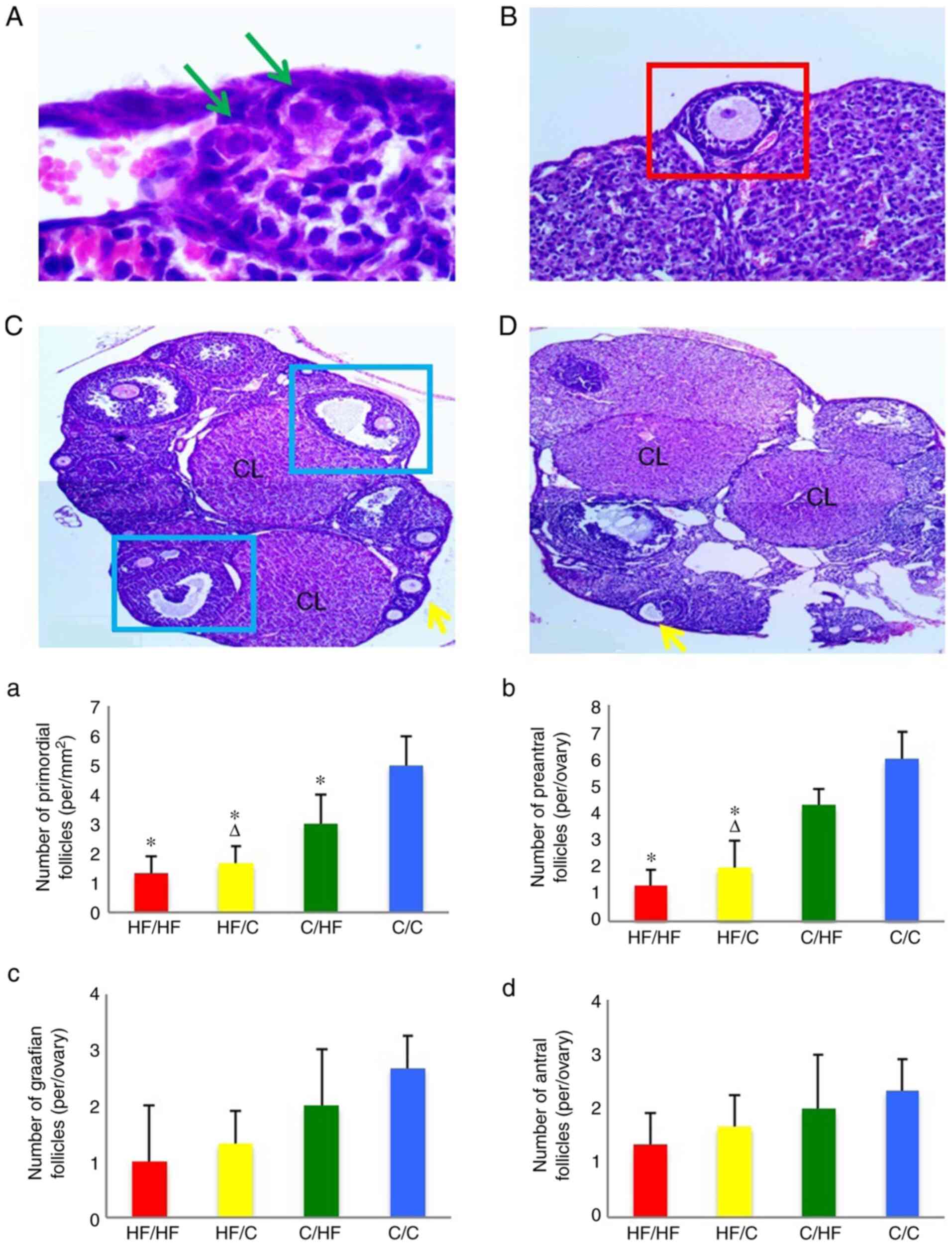|
1
|
McIntyre HD, Catalano P, Zhang C, Desoye
G, Mathiesen ER and Damm P: Gestational diabetes mellitus. Nat Rev
Dis Primers. 5(47)2019.PubMed/NCBI View Article : Google Scholar
|
|
2
|
Poston L, Caleyachetty R, Cnattingius S,
Corvalán C, Uauy R, Herring S and Gillman MW: Preconceptional and
maternal obesity: Epidemiology and health consequences. Lancet
Diabetes Endocrinol. 4:1025–1036. 2016.PubMed/NCBI View Article : Google Scholar
|
|
3
|
Stephenson J, Heslehurst N, Hall J,
Schoenaker DA, Hutchinson J, Cade JE, Poston L, Barrett G, Crozier
SR, Barker M, et al: Before the beginning: Nutrition and lifestyle
in the preconception period and its importance for future health.
Lancet. 391:1830–1841. 2018.PubMed/NCBI View Article : Google Scholar
|
|
4
|
Hohos NM and Skaznik-Wikiel ME: High-fat
diet and female fertility. Endocrinology. 158:2407–2419.
2017.PubMed/NCBI View Article : Google Scholar
|
|
5
|
Cheong Y, Sadek KH, Bruce KD, Macklon N
and Cagampang FR: Diet-induced maternal obesity alters ovarian
morphology and gene expression in the adult mouse offspring. Fertil
Steril. 102:899–907. 2014.PubMed/NCBI View Article : Google Scholar
|
|
6
|
Lu J, Wang Z, Cao J, Chen Y and Dong Y: A
novel and compact review on the role of oxidative stress in female
reproduction. Reprod Biol Endocrinol. 16(80)2018.PubMed/NCBI View Article : Google Scholar
|
|
7
|
Di Segni C, Silvestrini A, Fato R,
Bergamini C, Guidi F, Raimondo S, Meucci E, Romualdi D, Apa R,
Lanzone A and Mancini A: Plasmatic and intracellular markers of
oxidative stress in normal weight and obese patients with
polycystic ovary syndrome. Exp Clin Endocrinol Diabetes.
125:506–513. 2017.PubMed/NCBI View Article : Google Scholar
|
|
8
|
Catalano PM and Shankar K: Obesity and
pregnancy: Mechanisms of short term and long term adverse
consequences for mother and child. BMJ. 356(j1)2017.PubMed/NCBI View
Article : Google Scholar
|
|
9
|
Livak KJ and Schmittgen TD: Analysis of
relative gene expression data using real-time quantitative PCR and
the 2(-Delta Delta C(T)) method. Methods. 25:402–408.
2001.PubMed/NCBI View Article : Google Scholar
|
|
10
|
Mochizuki K, Hariya N, Honma K and Goda T:
Relationship between epigenetic regulation, dietary habits, and the
developmental origins of health and disease theory. Congenit Anom
(Kyoto). 57:184–190. 2017.PubMed/NCBI View Article : Google Scholar
|
|
11
|
Hanson M, Barker M, Dodd JM, Kumanyika S,
Norris S, Steegers E, Stephenson J, Thangaratinam S and Yang H:
Interventions to prevent maternal obesity before conception, during
pregnancy, and post partum. Lancet Diabetes Endocrinol. 5:65–76.
2017.PubMed/NCBI View Article : Google Scholar
|
|
12
|
Da Broi MG, Giorgi VSI, Wang F, Keefe DL,
Albertini D and Navarro PA: Influence of follicular fluid and
cumulus cells on oocyte quality: Clinical implications. J Assist
Reprod Genet. 35:735–751. 2018.PubMed/NCBI View Article : Google Scholar
|
|
13
|
Hohos NM, Cho KJ, Swindle DC and
Skaznik-Wikiel ME: High-fat diet exposure, regardless of induction
of obesity, is associated with altered expression of genes critical
to normal ovulatory function. Mol Cell Endocrinol. 470:199–207.
2018.PubMed/NCBI View Article : Google Scholar
|
|
14
|
Petrakis D, Vassilopoulou L, Mamoulakis C,
Psycharakis C, Anifantaki A, Sifakis S, Docea AO, Tsiaoussis J,
Makrigiannakis A and Tsatsakis AM: Endocrine disruptors leading to
obesity and related diseases. Int J Environ Res Public Health.
14(1282)2017.PubMed/NCBI View Article : Google Scholar
|
|
15
|
Radin L, Šimpraga M, Vince S, Kostelić A
and Milinković-Tur S: Metabolic and oxidative status of Saanen
goats of different parity during the peripartum period. J Dairy
Res. 82:426–433. 2015.PubMed/NCBI View Article : Google Scholar
|
|
16
|
Bisht S, Faiq M, Tolahunase M and Dada R:
Oxidative stress and male infertility. Nat Rev Urol. 14:470–485.
2017.PubMed/NCBI View Article : Google Scholar
|
|
17
|
Turinetto V and Giachino C: Multiple
facets of histone variant H2AX: A DNA double-strand-break marker
with several biological functions. Nucleic Acids Res. 43:2489–2498.
2015.PubMed/NCBI View Article : Google Scholar
|
|
18
|
Gao T, Diaz-Hirashi Z and Verdeguer F:
Metabolic signaling into chromatin modifications in the regulation
of gene expression. Int J Mol Sci. 19(4108)2018.PubMed/NCBI View Article : Google Scholar
|
|
19
|
Lee S and Dong HH: FoxO integration of
insulin signaling with glucose and lipid metabolism. J Endocrinol.
233:R67–R79. 2017.PubMed/NCBI View Article : Google Scholar
|
|
20
|
Ma J, Matkar S, He X and Hua X: FOXO
family in regulating cancer and metabolism. Semin Cancer Biol.
50:32–41. 2018.PubMed/NCBI View Article : Google Scholar
|
|
21
|
Manning BD and Toker A: AKT/PKB signaling:
Navigating the network. Cell. 169:381–405. 2017.PubMed/NCBI View Article : Google Scholar
|
|
22
|
Fasano C, Disciglio V, Bertora S, Lepore
Signorile M and Simone C: FOXO3a from the nucleus to the
mitochondria: A round trip in cellular stress response.
Cells-Basel. 8(1110)2019.PubMed/NCBI View Article : Google Scholar
|


















